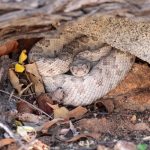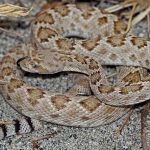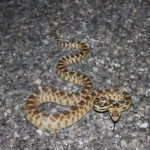Santa Catalina Rattlesnake is a species of relatively small, slender, venomous snake endemic to the Santa Catalina Island in the Gulf of California off the coast of Mexico. The species is mainly nocturnal and terrestrial. The most distinctive feature of this rattlesnake is that it lacks a rattle.
| Kingdom |
Animalia |
| Phylum |
Chordata |
| Class |
Reptilia |
| Order |
Squamata |
| Suborder |
Serpentes |
| Family |
Viperidae |
| Genus |
Crotalus |
| Scientific Name |
Crotalus catalinensis |
| Other Names |
Santa Catalina Island rattlesnake |
| Length |
Up to 73.1 cm (28.8 in) |
| Color |
Comes in two color variations; the common form has light cream base color with reddish-brown blotches down the back and black and white banding in the tail region; the other less frequent form is ash-gray with dark gray markings |
| Distribution |
Found only on Santa Catalina Island in the Gulf of California off the east coast of the state of Baja California Sur, Mexico |
| Habitat |
Found in the narrow, sandy, dry creeks known as arroyos with plenty of vegetation; can also be found under roots and rocks on the hillsides or in open areas of sandy soils |
| Diet |
Rodents, lizards |
| Predators |
Feral cats (introduced) |
| Breeding Season |
Between spring and early summer |
| IUCN Conservation Status |
Critically Endangered |
Santa Catalina Rattlesnake Pictures Gallery
-

-
Crotalus Catalinensis
-

-
Images of Santa Catalina Rattlesnake
-

-
Santa Catalina Island Rattlesnake
-

-
Santa Catalina Rattlesnake Images
-

-
Santa Catalina Rattlesnake Pictures
-

-
Santa Catalina Rattlesnake
-

-
Santa Catalina Rattlesnakes
-

-
Santa Catalina Rattlesnake Photos













